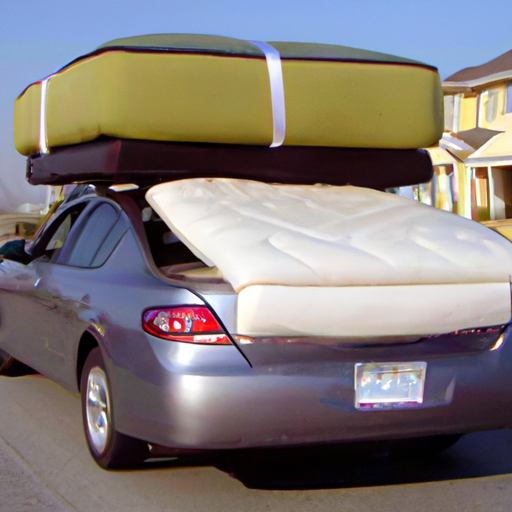Moving can be a stressful process, especially when it comes to transporting large and bulky items like a mattress. However, fret not! In this article, we will explore the best way to tackle this daunting task and ensure that your mattress arrives safely and in perfect condition at your new home. Whether you are moving locally or long-distance, we’ve got you covered with practical tips and tricks that will make your mattress transportation a breeze. So, let’s dive in and discover the ideal solution for transporting your mattress during a move. Moving to a new location can be an exciting and stressful time. One of the biggest challenges during the moving process is figuring out the best way to transport your mattress. After all, your mattress plays a crucial role in your comfort and sleep quality, so it’s important to ensure that it arrives at your new home in good condition. In this article, we will explore various methods and considerations for transporting a mattress, from choosing the right moving vehicle to unloading and setting up at the new location. Let’s dive in!
Review contents
Choosing the Right Moving Vehicle
Before you start preparing your mattress for transportation, it’s important to consider the size of your mattress and evaluate the available options for moving vehicles. Depending on the size of your mattress and the amount of other belongings you need to transport, you may need to rent a moving truck or consider hiring professional movers.
A moving truck can be a great option if you have a large mattress, such as a king or queen size, and a significant amount of furniture and belongings to transport. Renting a moving truck gives you the flexibility to transport your mattress along with all your other items in a single trip. It also provides the necessary space and security for your mattress to avoid any damage during transit.
If you have a smaller mattress or a limited number of belongings, you may consider using your own vehicle for transportation. However, it’s crucial to check if your mattress fits in your own vehicle before making any final decisions. Measure the dimensions of your mattress and compare them to the available space in your car or SUV. It’s better to be safe than sorry and avoid any last-minute surprises on moving day.
Preparing the Mattress for Transportation
Once you have chosen the right moving vehicle, it’s time to prepare your mattress for transportation. This step is crucial to ensure that your mattress remains clean and protected during the move. Here are some steps you can follow to prepare your mattress:
-
Clean and remove all bedding: Before you start packing your mattress, remove all the bedding, including sheets, blankets, and pillows. Give your mattress a good vacuum to remove any dust or dirt that may have accumulated.
-
Protect the mattress with a mattress cover: Invest in a mattress cover or bag to protect your mattress from dirt, dust, and moisture during transportation. A mattress cover will provide an extra layer of protection and keep your mattress clean and hygienic.
-
Consider using a mattress bag: If you want an additional layer of protection, you can opt for a mattress bag. These heavy-duty plastic bags are specifically designed to protect mattresses during transportation. They seal tightly around the mattress, keeping it safe from dust, dirt, and potential tears.
-
Secure the covers with tape or straps: Once you have covered your mattress with a mattress cover or bag, secure the covers tightly using tape or straps. This will ensure that the covers stay in place and provide full protection to your mattress during transit.
-
Use additional padding or blankets: If you have any additional padding or blankets, consider using them to provide extra cushioning and protection for your mattress. Place them around the sides of the mattress to absorb any impact during transportation.
By following these steps, you can be confident that your mattress will be well-protected and arrive at your new location in excellent condition.
Disassembling the Bed Frame
In addition to preparing your mattress, you may also need to disassemble your bed frame before transporting it. Disassembling the bed frame can make it easier to maneuver and transport, especially if you have a large or bulky frame. Here’s how you can go about disassembling your bed frame:
-
Check if the bed frame can be disassembled: Some bed frames are designed to be easily disassembled, while others may require more effort. Check the manufacturer’s instructions or do some research online to determine if your bed frame can be disassembled.
-
Gather necessary tools: Before you start disassembling your bed frame, gather all the necessary tools, such as a screwdriver, Allen wrench, or socket set. Having the right tools on hand will make the process much smoother and efficient.
-
Start by removing the mattress and box spring: Before you can disassemble the bed frame, remove the mattress and box spring. This will give you better access to the frame and make it easier to disassemble.
-
Disconnect and label all components: Carefully disconnect all the components of the bed frame, such as the headboard, footboard, side rails, and support beams. As you disassemble each piece, label them or take note of how they fit together. This will make reassembly much easier at your new location.
-
Secure loose parts to prevent damage: Once you have disassembled the bed frame, secure all loose parts together using tape or zip ties. This will prevent any damage to the components during transportation.
By following these steps, you can efficiently disassemble your bed frame and ensure that it arrives safely at your new home.
Lifting and Maneuvering the Mattress
Now that your mattress and bed frame are prepared for transportation, the next step is to safely lift and maneuver the mattress. Moving a mattress can be a physically demanding task, so it’s important to take the necessary precautions to avoid any injuries and ensure the safety of your mattress. Here are some tips to help you with lifting and maneuvering your mattress:
-
Enlist the help of friends or family: Moving a mattress should never be done alone. Enlist the help of friends or family members to assist you with lifting and carrying the mattress. Having additional hands will make the task much easier and safer.
-
Use proper lifting techniques: When lifting the mattress, use proper lifting techniques to avoid straining your back or causing any injuries. Bend your knees and lift with your legs, keeping your back straight. Avoid twisting your body while lifting.
-
Consider using a mattress sling: If you have a particularly heavy or bulky mattress, consider using a mattress sling. A mattress sling is a specialized carrying strap that allows you to distribute the weight of the mattress evenly and provides better control during transport.
-
Take precautions when going up and down stairs: If you have stairs to navigate during the move, take extra care when carrying the mattress. Ensure that the pathway is clear and well-lit, and consider using a mattress sling for added stability. Take each step slowly and carefully to avoid any accidents.
-
Watch out for doorways and narrow spaces: Doorways and narrow spaces can pose challenges when moving a mattress. Measure the dimensions of doorways and hallways in advance to ensure that your mattress can pass through without any issues. Remove any obstacles or furniture that may hinder the pathway.
By following these tips, you can safely lift and maneuver your mattress, minimizing the risk of injuries and ensuring that your mattress remains in good condition.
Loading the Mattress into the Moving Vehicle
Once you have safely lifted and maneuvered the mattress, it’s time to load it into the moving vehicle. Proper loading is crucial to prevent any damage to your mattress during transportation. Here are some steps to help you load your mattress into the moving vehicle:
-
Clear a path to the vehicle: Before bringing the mattress to the moving vehicle, clear a path to ensure a smooth and unobstructed loading process. Remove any debris or obstacles that may get in the way.
-
Ensure the mattress is properly balanced: Before lifting the mattress into the vehicle, make sure it is balanced properly. Ensure that the weight is evenly distributed to avoid any tipping or shifting during transit.
-
Lift the mattress into the vehicle: Enlist the help of your friends or family members to lift the mattress into the moving vehicle. Use proper lifting techniques as described earlier to ensure everyone’s safety.
-
Secure the mattress to prevent movement: Once the mattress is inside the vehicle, secure it to prevent any movement during transit. Use straps or bungee cords to tightly fasten the mattress to the walls or floor of the vehicle. This will prevent the mattress from sliding or tipping over during transportation.
-
Consider using straps or bungee cords: In addition to securing the mattress to the moving vehicle, you can also use straps or bungee cords to secure the mattress to other furniture or items in the vehicle. This will provide an extra layer of stability and prevent any potential damage.
By following these steps, you can confidently load your mattress into the moving vehicle, ensuring its safety and protection throughout the journey to your new location.
Securing the Mattress in the Moving Vehicle
Once the mattress is loaded into the moving vehicle, the next step is to secure it properly. Properly securing the mattress will help prevent any damage or shifting during the transportation process. Here are some tips to help you secure the mattress in the moving vehicle:
-
Place the mattress in a stable position: Find a stable position within the moving vehicle where the mattress can be placed securely. Ideally, it should be against a wall or flat on the floor to minimize any movement or shifting.
-
Avoid stacking heavy items on top: When loading other items into the moving vehicle, avoid stacking heavy items on top of the mattress. The weight from heavy items can cause the mattress to compress or become damaged.
-
Use tie-downs or ropes to secure the mattress: After placing the mattress in a stable position, use tie-downs or ropes to secure it to the walls or floor of the moving vehicle. Ensure that the ties are tight and hold the mattress firmly in place.
-
Consider using moving blankets for extra protection: If you have additional moving blankets, you can use them to provide extra protection for the mattress. Wrap the mattress with the blankets, especially on the sides facing other items, to prevent any scratches or damage.
-
Double-check the security of the mattress: Before you start driving to your new location, double-check the security of the mattress. Ensure that all ties, straps, or ropes are tight and properly secured. Give the mattress a gentle push to confirm that it is stable and won’t move during transit.
By following these steps, you can ensure that your mattress remains secure and protected while in transit in the moving vehicle.
Unloading and Setting Up at the New Location
Now that you have arrived at your new location, it’s time to unload and set up your mattress. This is the final step in the transportation process, and it’s crucial to handle the mattress with care to avoid any damage. Follow these steps to safely unload and set up your mattress:
-
Carefully remove the mattress from the vehicle: Open the doors of the moving vehicle and carefully remove the mattress. Enlist the help of friends or family members to ensure a smooth and safe removal process.
-
Choose a suitable location for the mattress: Before setting up the mattress, decide on a suitable location in your new home. Consider factors such as room size, accessibility, and personal preference. Ensure that the location is clear of any obstacles or furniture.
-
Assemble the bed frame if necessary: If you disassembled your bed frame before transportation, now is the time to reassemble it. Refer to the labels or notes you made during disassembly to ensure that you put the components together correctly.
-
Position the mattress correctly on the frame: Carefully position the mattress on the bed frame, ensuring that it aligns properly and fits securely. Take your time to make any necessary adjustments to ensure that the mattress is sitting evenly on the frame.
-
Remove the protective coverings: Once the mattress is in place, remove any protective coverings, such as mattress covers or bags. Fold or store them for future use or discard them appropriately.
By following these steps, you can safely unload and set up your mattress in your new location, ensuring a comfortable and restful night’s sleep.
Alternative Methods for Transporting a Mattress
While the methods discussed so far are commonly used for transporting mattresses, there are some alternative methods you can consider depending on your specific circumstances. Here are a few alternative methods for transporting a mattress:
-
Using a roof rack or trailer: If you have a vehicle with a roof rack or a trailer hitch, you can transport your mattress on the roof or trailer. Ensure that the mattress is properly secured to avoid any accidents or damage during transit. This method is more suitable for shorter distances and favorable weather conditions.
-
Renting a self-storage unit for temporary storage: If you need to temporarily store your mattress during the moving process, you can consider renting a self-storage unit. Self-storage units provide a secure and climate-controlled environment for your mattress until you are ready to transport it to your new location.
-
Shipping the mattress through a moving service: If you are moving long-distance or don’t have access to a suitable moving vehicle, you can ship your mattress through a moving service. Many moving companies offer specific services for transporting mattresses and other large furniture items. They will safely pack and ship your mattress to your desired location.
-
Donating or selling the mattress before moving: If you no longer need your current mattress or it’s not worth the effort and cost to transport it, you can consider donating or selling it before moving. Many charitable organizations accept mattress donations, and selling it can help recoup some of the moving expenses.
-
Considering mattress disposal options: If your mattress is old, worn out, or damaged, you may need to consider mattress disposal options. Check with your local waste management facility or recycling centers to find out the proper methods for disposing of your mattress. Some organizations also offer mattress recycling services.
By exploring these alternative methods, you can find the best option that suits your specific needs and circumstances during the moving process.
Tips and Considerations
To ensure a smooth and successful transportation process for your mattress, keep the following tips and considerations in mind:
-
Measure doorways and hallways in advance: Measure the dimensions of doorways, hallways, and stairwells in both your current and new locations. This will help you determine if your mattress can fit through without any issues or require additional maneuvering.
-
Protect the mattress from moisture during transport: Moisture can damage your mattress during transportation, so take measures to protect it. If transporting in an open vehicle, cover the mattress with a waterproof tarp or plastic sheeting. Consider using moisture-absorbing products like desiccant packets to keep the mattress dry.
-
Avoid dragging the mattress on rough surfaces: Dragging the mattress on rough surfaces can cause tears or damage to the fabric. Whenever possible, lift and carry the mattress instead of dragging it. If dragging is unavoidable, place a protective barrier, such as a thick blanket or cardboard, between the mattress and the rough surface.
-
Communicate with movers if hiring professionals: If you decide to hire professional movers, communicate your specific requirements and concerns regarding your mattress. Provide them with accurate measurements and any special instructions to ensure that your mattress is handled with care during the transportation process.
-
Allow the mattress to air out after transportation: Once you have set up your mattress in your new location, allow it to air out for a few hours before using it. This will help remove any odors or moisture that may have accumulated during transportation.
By keeping these tips and considerations in mind, you can take proactive measures to ensure a successful and stress-free transportation process for your mattress.
Conclusion
In conclusion, choosing the best way to transport a mattress when moving requires careful consideration and planning. The size of your mattress, the available options for moving vehicles, and your personal circumstances all play a role in determining the most suitable method. Whether you decide to rent a moving truck, hire professional movers, or use your own vehicle, it’s important to prioritize the safety and protection of your mattress.
Preparing your mattress for transportation by cleaning it, using protective coverings, and securing it properly will help ensure that it arrives at your new location in good condition. If necessary, disassembling your bed frame and following proper lifting techniques will make maneuvering the mattress easier and safer.
When loading the mattress into the moving vehicle, clear a path, ensure proper balance, and tightly secure it to prevent any movement. At the new location, unload the mattress carefully, choose a suitable location, and set it up correctly on the bed frame. Finally, consider alternative methods for transporting a mattress and keep in mind helpful tips and considerations throughout the process.
Remember, the best method for transporting your mattress ultimately depends on your individual circumstances. Consider factors such as your budget, available resources, and the importance of protecting your mattress. By prioritizing the safety and protection of your mattress, you can ensure that it arrives safely and allows you to enjoy comfortable sleep in your new home.
























